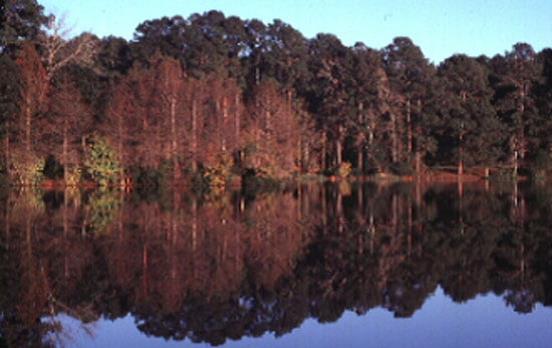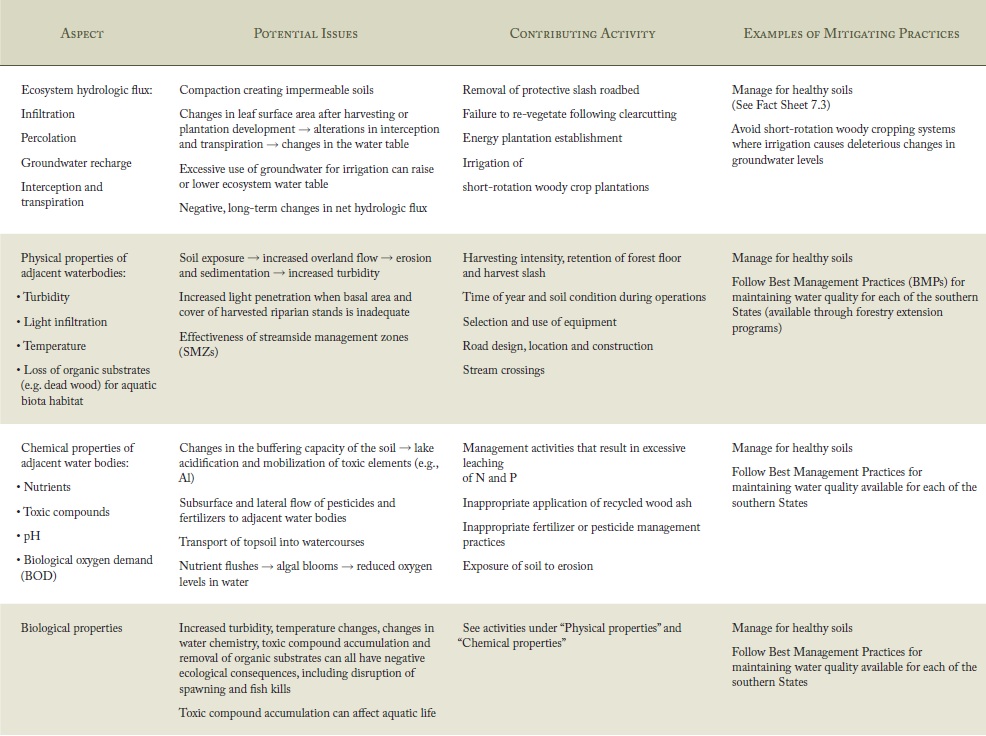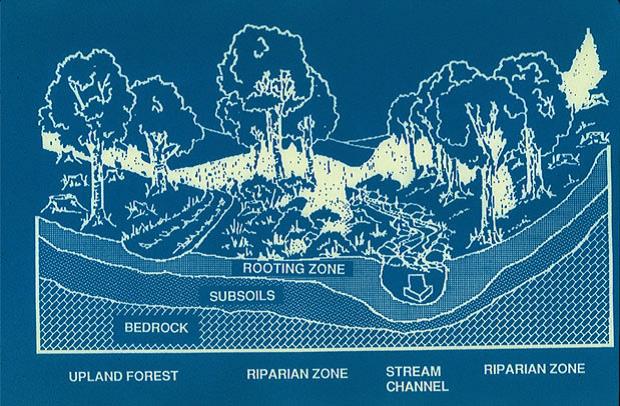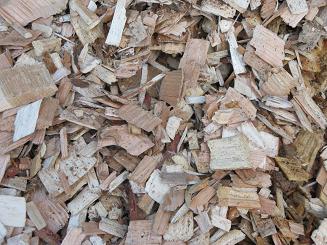Introduction
Forestlands serve as watershed areas for much of the southern United States. These 214 million acres of forested areas are constantly collecting, filtering, storing and transporting billions of gallons of water a day to communities all over the South. The activities that take place on these watersheds affect us all. Forest managers and landowners interested in bioenergy production must understand how forested watersheds function; how management operations impact watersheds; and their functions and effects on various plant, animal and human communities. (Image 1).
Two key hydrologic values are affected by forest operations: water quantity and water quality. Intensive management for bioenergy production systems could have a negative impact on water resources. Yet, water flow through a watershed is also affected by many inter-related factors such as climate, soils and geology, and other environmental factors that vary from site to site. Table 1 provides a concise summary of the potential effects of bioenergy production on water quantity and quality.
This fact sheet reviews research findings and management recommendations relating to water conservation in bioenergy production systems. Those interested in more information can access the online forest encyclopedia at http://www.forestencyclopedia.net or contact their local Natural Resource Conservation Specialist, Cooperate Extension agent, or state forestry agency professional.

Image 1. Water quality should be excellent in forested watersheds. source: Eric Taylor, Texas Cooperative Extension
Bioenergy Production and Water Quantity
The term “water quantity” refers to the timing and total yield of water from a watershed, and is measured by such variables as total yield and peak flow1. Total yield is the total amount of available water that flows from a watershed over a specified period. Removing vegetation and litter from a watershed during biomass removal for bioenergy allows more water to fall directly on the soil surface and infiltrate to groundwater and streams. Total yield from a watershed is generally increased for at least one year after harvesting, and is primarily related to the change in vegetative cover. The actual variance depends on a number of factors including amount and type of vegetation cleared, climate and weather, terrain, geology, time of year, and soil types and conditions.
Peak flows occur during times of extreme weather, such as rainstorms, spring snow melt, and after catastrophic wildfire. The effect of forest management on peak flows highly depends upon individual site characteristics. Intensive management, such as that associated with bioenergy production systems, can increase the risk of higher peak flows. However, severe wildfires create an even greater risk. Forest managers in regions with high wildfire potential must balance adverse risks associated with thinning operations to reduce wildfire fuel loads against the risk of wildfire in dense, overstocked stands. Thinning stands for energy feedstock may reduce risks for both wildfire and damaging watershed peak flows.
Increases in groundwater infiltration due to extensive vegetation removal can raise water tables, potentially resulting in soil saturation and a loss of productivity2. This depends upon specific site characteristics. On the other hand, plantations of short-rotation woody crops (e.g., willow, poplar) can deplete groundwater resources, especially if irrigation is required3. Try to avoid such plantations in areas where long-term regional groundwater availability could be a concern.
Stream and water table response to management and harvesting typically depend on the percentage reduction in leaf area. But also strongly depend on the soils, geology, and climate of a specific watershed.

Table 1. Potential Environmental Impacts of Bioenergy Harvesting on Water Quality and Quantity
Water Quality and Bioenergy Production Systems
The term “water quality” refers to the suitability of water for drinking, recreational uses, and as habitat for aquatic organisms and other wildlife1. Water quality is measured by the amount of sediment, water temperature, and concentration of chemical compounds, including nitrate-nitrogen and other nutrients in the water. High concentrations of nitrate-nitrogen in drinking water are a concern for human health. In addition to human health risks, high concentrations of nitrogen and phosphorus are related to algal growth in surface water bodies, which can lead to eutrophication and the death of aquatic fauna. No large, long-term increases in nitrate-nitrogen levels have been observed following intensive forest harvesting operations such as biomass harvesting for bioenergy, however. Ecosystem nutrient cycling dynamics tend to conserve nitrogen as revegetation occurs. Use of herbicides, chemical fertilizers, and atmospheric deposition are more likely to adversely affect stream nitrate-nitrogen levels than forest biomass harvesting operations. To avoid this issue, carefully monitor the use of herbicides and fertilizers in biomass production (including recycled wood ash) and adhere to prescribed guidelines
Road construction is often the major source of sediment movement to streams in managed forests. Risks rise with an increase in road networks to access previously unmerchantable fiber and leaving roads open longer to harvest energy feedstocks in addition to conventional harvesting. Intensive harvesting and site preparation operations also increase the risk of erosion and movement of sediment to surface waters(4,5). Reduce these risks by practicing one-pass harvesting and making the best use of already existing roads. In addition, apply Best Management Practices during road construction, site preparation operations and other silvicultural and stand management activities to mitigate the potential for sediment movement and reductions in water quality.
Best Management Practices have been developed by all 13 of the southern states. The BMPs provide guidelines for forest operations that ensure the quantity and quality of water coming from forested watersheds is excellent. Obtain Best Management Practice handbooks and guidelines through forestry Cooperative Extension and state forestry programs in each state. A region-wide collection of policies and related resources is available at http://forestrybmp.net. These Best Management Practices have proven effective in maintaining water quality in biomass production systems6.
Intensive biomass harvesting operations, particularly clearcutting adjacent to streams, may have an adverse effect on water temperature and may contribute to toxic compound accumulation. Removing the forest canopy adjacent to streams can result in temperature increases in summer which are lethal to some aquatic organisms7. Intensive harvesting can also decrease the buffering capacity of soils, leading to lake acidification and the mobilization of toxic elements like aluminum8. Pay special attention to reducing the potential for adverse impacts of harvesting operations on aquatic resources.
One way to maintain high water quality on and adjacent to sites where biomass is harvested for bioenergy is to apply the concept of streamside management zones (SMZs) (Image 2) in which cover is retained in riparian areas adjacent to surface water and aquatic habitats. These zones are included in Best Management Practices and are helpful to maintain high levels of water quality. Take into consideration the areas directly surrounding the stream and water bodies when planning the placement of SMZs. Site-specific management is required to conserve water resources.

Image 2. The creation of Streamside Management Zones helps to maintain water quality in forested areas. source: C. T. Smith
Conclusions
High standards for water quantity and quality can be achieved in forests managed for bioenergy production. As with any intensive management system, adhering to Best Management Practices and integrating streamside management zones into forest management plans can ensure the sustainability of our precious water resources.
Endnotes
1 Neary, D.G. 2002. Hydrologic values. In: Richardson, J.; Bjorheden, R.; Hakkila, P.; Lowe, A.T.; and Smith, C.T., eds. Bioenergy from Sustainable Forestry: Guiding Principles and Practice. Dordrecht, The Netherlands: Kluwer Academic Publishers: 190-215.
2 Eigenbrod, K.D. and Kaluza, D. 1999. Shallow slope failures in clays as a result of decreased evapotranspiration subsequent to forest clearing. Natural Resources Canada Publication. Available online at: http://article.pubs.nrc-cnrc.gc.ca/ppv/RPViewDoc?_handler_=HandleInitial… [Accessed March 20 2006].
3 Van der Salm, C., van der Gon, H.D., Wieggers, R., Bleeker, A., and van den Toorn, A. 2006. The effect of afforestation on water recharge and nitrogen leaching in the Netherlands. Forest Ecology and Management . 170-182 .
4 Rice, R.M., Ziemer, R.R., and Lewis, J. 2001. Forest management effects on erosion, sediment and runoff: lessons from Caspar Creek and northwestern California. Available online at: http://www.humboldt.edu/~rrz7001/pubs/RiceProc.pdf [Accessed February 26 2007].
5 Moore, Susan. E. 1999. Forests, Hydrology, and Water Quality: Impacts of Silvicultural Practices. University of Florida IFAS Extension Paper. Available online at: http://edis.ifas.ufl.edu FR009#FOOTNOTE_1.
6 Shepard, J. P. 2006. Water quality protection in bioenergy production: the US system of forestry Best Management Practices. Biomass and Bioenergy. 30(4): 378-384.
7 Holopainen, A.L, and Huttunen, P. 1992. Effects of forest clear-cutting and soil disturbance on the biology of small forest brooks. Hydrobiologica. 243: 457-464
8 Vuori, K-M, Siren, O., and Luotonen, H. 2003. Metal contamination of streams in relation to catchment silvicultural practices: a comparative study in Finnish and Russian headwaters. Boreal Environment Research. 8: 61-70.
